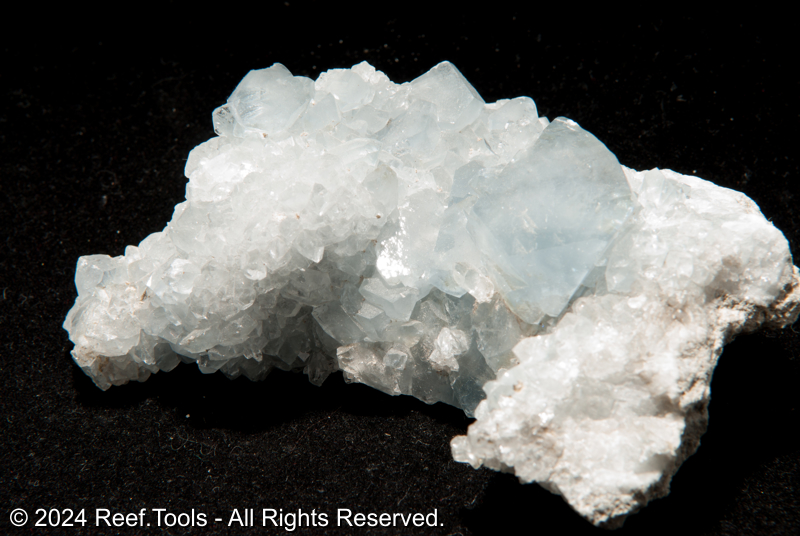
Strontium (Sr)
Alkaline Earth Metals
Atomic Number: 38
Last Reviewed: 12/15/2024
Strontium is an alkaline earth metal and a naturally occurring trace element in seawater. While it is incorporated into the skeletal structures of corals and other marine organisms, its presence appears incidental, driven by chemical substitution with calcium, rather than by biological necessity. Its role in reef aquariums is widely debated, with limited scientific evidence supporting claims of essentiality.
Natural Seawater Levels
Natural seawater contains strontium at approximately 7.2 to 8.2 mg/L, with a consistent ratio of ~1:10,000 to calcium.
Risks
Deficiency:
- Strontium deficiency is rare in reef aquariums, as regular water changes maintain natural levels. Low strontium levels are unlikely to impair coral health unless calcium levels are also deficient.
- Deficiency symptoms, if present, are difficult to distinguish from calcium-related issues.
Excess:
- Elevated strontium concentrations can lead to precipitation of unwanted minerals and disrupt the ionic balance of aquarium water. Excessive strontium may also interfere with calcification processes in marine organisms.
Relevancy
Skeletal Incorporation:
- Strontium is absorbed into the aragonite lattice of coral skeletons and shells due to its chemical similarity to calcium. This substitution occurs passively and does not appear to be biologically regulated. (Steinmetz, 1983)
Potential Effects on Density:
- Some studies suggest strontium may influence skeletal density in corals, but these effects are subtle and do not confer a survival advantage.
No Known Biological Role:
- Unlike calcium, which is critical for calcification and cellular functions, strontium’s biological necessity remains unproven. Its incorporation appears incidental, tied to its chemical properties rather than biological processes.
Ocean Values
| Reference Name | Low | High | Optimal | Unit |
|---|---|---|---|---|
| Australia Ocean | 8.0000 | 10.0000 | 8.4000 | mg/L |
| Florida Ocean | 8.0000 | 11.0000 | 8.9000 | mg/L |
| Caribbean Ocean | 8.0000 | 10.0000 | 8.6000 | mg/L |
Regional Variations
Strontium concentrations in seawater are relatively uniform, with minor variations based on geological and environmental factors.
Dosage Recommendations
Target Level: Maintain strontium concentrations between 7.2 and 8.2 mg/L, consistent with natural seawater levels.
Adjustment: Supplementation should only be undertaken if accurate testing indicates a deficiency, with careful dosing to avoid exceeding natural levels.
Handling
Testing: Advanced testing (ICP-OES) is the most reliable method for monitoring strontium levels.
Intervention: Only consider supplementation if depletion is confirmed through reliable testing. Avoid blind dosing to prevent ionic imbalances.
Reef.Tools recommends: Maintain Strontium (Sr) concentrations between 6.0000 and 10.0000 mg/L.
References
- Steinmetz, H. (1983). "Incorporation of Strontium into Coral Skeletons: A Physicochemical Study." Journal of Experimental Marine Biology and Ecology. (DOI)
- Cohen, A. L., & McConnaughey, T. A. (2003). "Geochemical Perspectives on Coral Calcification." Geochemistry, Geophysics, Geosystems. (DOI)
- Marshall, A. T., & Clode, P. L. (2004). "Calcification in Corals: Effects of Calcium and Strontium Concentration." Marine Environmental Research. (DOI)
- Angino, E. E., Billings, G. K., & Andersen, N. (1966). "Observed Variations in the Strontium Concentration of Sea Water." Chemical Geology. (DOI)
Difficulty
Rating: Easy
Strontium levels are naturally maintained through routine water changes and proper calcium management, making it easy to manage in most reef systems.
Categorization
Element Type: Alkaline Earth Metal
Role: Trace Element (Non-essential)
Not Usually Deficient
Regular water changes with high-quality salt mixes replenish strontium naturally, making deficiencies rare.
Not Essential
Debatable. While strontium is incorporated into the skeletal structures of marine organisms, its necessity for biological processes is not conclusively established.
Aliases
Sr